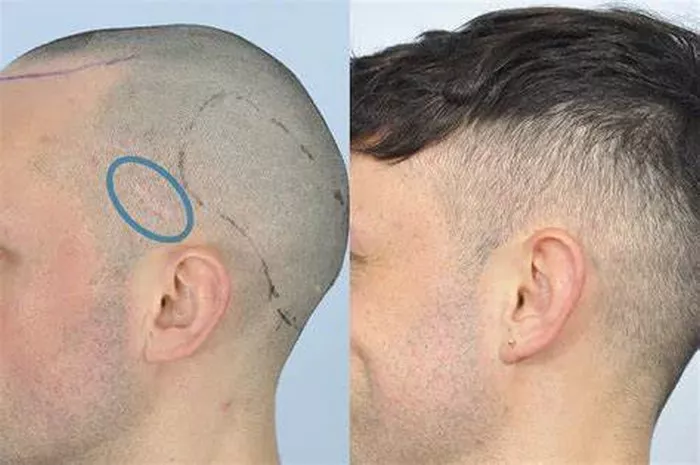Hair transplant surgery has become a popular solution for hair loss, offering individuals the chance to regain their confidence and youthful appearance. However, one common concern associated with this procedure is the potential for scarring. While modern techniques have significantly minimized the risk of noticeable scars, some individuals may still experience them. This article explores the causes of hair transplant scars and provides comprehensive solutions to fix and minimize their appearance.
Understanding Hair Transplant Scars
Types of Hair Transplant Techniques and Associated Scarring
There are two primary hair transplant techniques: Follicular Unit Transplantation (FUT) and Follicular Unit Extraction (FUE). Each method has its own potential for scarring.
1. Follicular Unit Transplantation (FUT):
Method: Involves removing a strip of scalp from the donor area (usually the back of the head) and then dissecting it into individual follicular units for transplantation.
Scarring: FUT typically results in a linear scar in the donor area. The size and visibility of this scar can vary depending on the skill of the surgeon and the patient’s healing process.
2. Follicular Unit Extraction (FUE):
Method: Involves extracting individual hair follicles from the donor area using a small, circular punch.
Scarring: FUE results in tiny, dot-like scars scattered throughout the donor area. These scars are generally less noticeable than the linear scar from FUT.
Factors Influencing Scar Formation
Several factors can influence the formation and visibility of scars following a hair transplant:
Surgeon’s Skill: An experienced and skilled surgeon can significantly reduce the risk of noticeable scarring.
Patient’s Healing Process: Individual healing processes vary, and some people may be more prone to noticeable scarring.
Post-Operative Care: Proper care and following post-operative instructions can minimize scar formation.
Solutions to Fix Hair Transplant Scars
1. Scar Revision Surgery
Scar revision surgery involves surgically removing or altering the scar tissue to make it less noticeable. This can be particularly effective for linear scars resulting from FUT. The surgeon may use techniques such as:
Trichophytic Closure: A technique where the edges of the scar are trimmed to allow hair to grow through the scar, making it less visible.
Excision and Re-Closure: The old scar is excised, and the skin is re-closed with advanced suturing techniques to minimize the new scar’s visibility.
2. Scalp Micropigmentation (SMP)
Scalp micropigmentation is a non-surgical cosmetic procedure that involves tattooing tiny dots on the scalp to replicate the appearance of hair follicles. SMP can effectively camouflage both linear and dot-like scars by blending them with the surrounding hair.
Procedure: The practitioner uses a fine needle to deposit pigment into the scalp, creating the illusion of density and reducing the contrast between the scar and the natural scalp.
3. Laser Therapy
Laser therapy can be used to reduce the appearance of scars by promoting collagen production and skin remodeling. Different types of lasers can be used depending on the scar’s characteristics:
Fractional CO2 Lasers: These lasers create micro-injuries in the scar tissue, stimulating collagen production and improving skin texture.
Erbium Lasers: These lasers are effective for resurfacing the skin and reducing the thickness of scar tissue.
4. Platelet-Rich Plasma (PRP) Therapy
PRP therapy involves injecting concentrated platelets from the patient’s own blood into the scar tissue. Platelets contain growth factors that promote healing and tissue regeneration.
Procedure: Blood is drawn from the patient, processed to concentrate the platelets, and then injected into the scar. This can improve the texture and appearance of the scar over time.
5. Dermal Fillers
Dermal fillers can be used to elevate depressed scars, making them less noticeable. Fillers such as hyaluronic acid can be injected beneath the scar to create a smoother surface.
Procedure: The practitioner injects the filler into the scar tissue, elevating it to the level of the surrounding skin. This can be particularly effective for indented scars.
6. Topical Treatments
Several topical treatments can help improve the appearance of scars over time. These treatments may include:
Silicone Gels and Sheets: Silicone has been shown to reduce scar thickness and improve texture. Applying silicone gel or sheets to the scar can promote healing.
Steroid Injections: For hypertrophic (raised) scars, steroid injections can reduce inflammation and flatten the scar tissue.
Retinoids: Topical retinoids can promote skin cell turnover and improve the texture of scar tissue.
See Also: What is Ice FUE Hair Transplant: A Comprehensive Guide
7. Hair Transplantation into Scars
In some cases, transplanting hair follicles directly into the scar tissue can help camouflage the scar. This technique can be particularly effective for linear scars from FUT.
Procedure: The surgeon extracts healthy hair follicles from a donor area and implants them into the scar tissue. Over time, these follicles grow hair, blending the scar with the surrounding scalp.
Preventing Hair Transplant Scars
While there are several effective solutions for fixing hair transplant scars, prevention is always the best approach. Here are some tips to minimize the risk of scarring:
Choose a Skilled Surgeon: Research and select a surgeon with extensive experience and a proven track record in hair transplant surgery.
Follow Post-Operative Instructions: Adhere to all post-operative care instructions provided by your surgeon to promote proper healing and reduce the risk of complications.
Avoid Smoking and Alcohol: Smoking and excessive alcohol consumption can impair the healing process and increase the risk of scarring.
Maintain a Healthy Diet: A balanced diet rich in vitamins and minerals can support the healing process and promote healthy skin.
Conclusion
Hair transplant scars can be a concern for many individuals undergoing the procedure, but various effective solutions are available to fix and minimize their appearance. From surgical interventions and non-surgical treatments to preventative measures, there are multiple ways to achieve a flawless look. By understanding the causes of scarring and exploring the available options, you can make informed decisions to ensure the best possible outcome for your hair transplant journey.


